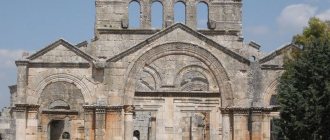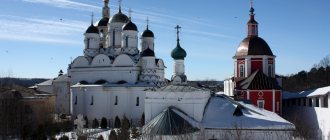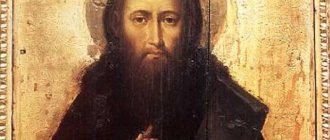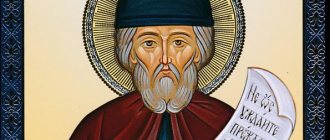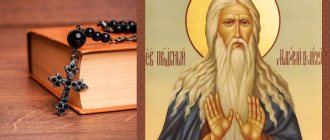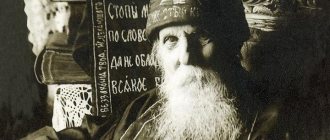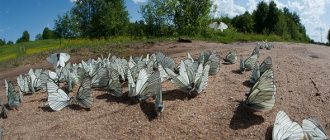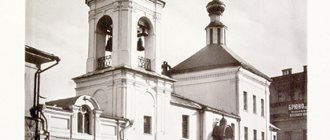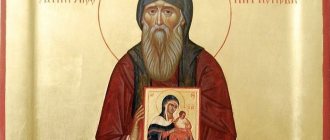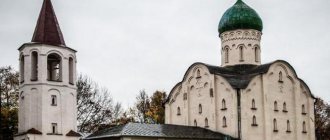| St. Simeon the Stylite |
Simeon the Stylite
(356 - 459), Venerable
Not to be confused with St.
Simeon Divnogorets, stylite “younger” (521 - 596, commemorated May 24) Commemorated September 1
Born in 356 in Cilicia from poor parents. Until the age of 18, Simeon tended his parents' sheep, then, secretly from his parents, he went to a monastery, at the gates of which he spent seven days, asking in vain for shelter. Finally admitted to this monastery, he spent two years there and moved to another, where the monks were distinguished by greater severity of life. The young monk made himself a belt from tree branches, which, having dried, pricked and tore his body. The abbot removed this belt from him, but, fearing that the example of self-torture would not find imitators, he removed Simeon from the monastery.
Simeon moved to the dry bottom of a deep lake. When they wanted to take him back to the monastery, he secretly went to the outskirts of Antioch and settled first in an abandoned hut at the foot of the mountain, and then at the very top of the mountain, where he surrounded his cell with a fence. An iron chain, one end chained to the fence, the other was attached to his leg, so that he could not go beyond his fence. Bishop Meletius of Antioch ordered him to take off the chain: “you can control yourself without shackles, you can tie yourself to a cause and a place with one mind and will.”
Then Simeon becomes world famous not only as an ascetic, but also as a wise spiritual mentor. He knew how to read minds and hearts and heal mental and partly physical ailments. He was recognized throughout the Roman Empire, as well as by the Persians, Medes, Saracens, Ethiopians, Iberians, and Scythians, who did not have permanent homes. The emperors wrote to him about their affairs.
In 423, he came up with that type of asceticism called pillarism. He erected a pillar, firmly fixed at the base, and at the top having a platform for standing and seating. At some distance the pillar was surrounded by a wall, beyond which no one had the right to enter. Simeon spoke to those who came to him from the upper platform, spoke passionately, prophetically to a whole crowd, and quietly, meekly to those who came alone. He spent most of his time on the site, although there were no devices for protection from heat or cold, from wind and rain. He labored on the pillar for more than 40 years, indulging in unceasing prayer. One day, says Theodoret, someone wanted to count how many bows an ascetic made at one time, counted them 1244 and, tired, did not continue counting, and Simeon continued to bow. On holidays, the saint stood on the platform of the pillar, with his hands stretched out in prayer, from sunset to sunrise.
Rumors about the Monk Simeon reached the highest church hierarchy and the imperial court. Patriarch Domnin of Antioch visited the saint, performed the Divine Liturgy on the pillar and communed the ascetic with the Holy Mysteries. The fathers who labored in the desert also learned about the Monk Simeon, who chose such a difficult form of asceticism. Wanting to test the new ascetic and find out whether God liked his exorbitant feats, they sent their envoys to him with the command to come down from the pillar and stop the feat, since such a path of salvation had not yet been known. At the same time, they ordered the messengers: in the case of Saint Simeon’s unquestioning obedience, to bless him to continue the pillar, and in case of disobedience, to forcibly remove him from the pillar. Hearing the order of the ascetic fathers, the Monk Simeon immediately began to descend. Then, convinced of his genuine humility, the messengers of the hermits stopped him and conveyed the blessing of the fathers to continue his ascetic work.
Probably, the pillar of Simeon only at the beginning consisted of one continuous thick tree trunk, as it is depicted in a very ancient drawing, reproduced by Bottari in the form of an engraving: here the upper half of the torso of an ascetic is visible, holding one end of a rope, to the other end of which is someone standing outside fences of the pillar, ties food or anything else needed by the ascetic. It is believed that this is an accurate image of the pillar of Simeon.
A cell of two square cubits was built on it; on the walls of the cell there was a light cover slightly taller than the saint’s height, which rotted over time. There was a door in the cell; when it opened, the people could see the saint. But subsequently the cell became so dilapidated that even in its crevices one could freely see him. The pillar reached 40 cubits in height, stood on a high mountain and was surrounded by two stone fences [1].
Saint Simeon lived for more than a hundred years and died during prayer in 459.
| Right hand of St. Simeon the Stylite. Verian Transfiguration Monastery |
Life of Saint Simeon the Stylite
The future Saint Simeon was born in Cappadocia, in the small village of Sisan. His parents accepted the Christian teaching and after the birth of the baby they baptized the child according to the teachings of Jesus. Susotion and Martha (that was the name of Simeon's father and mother) raised their son in simplicity and love, teaching him the truths of the Word of God from an early age. When the boy was 13 years old, he began to help his parents run the farm; his duties included herding sheep. Simeon treated his work responsibly and with love, so his parents could not be happier with their son.
While visiting a Christian church, during one of the sermons the young man heard the Beatitudes and was touched by their depth. But since he did not rely on his, as it seemed to him, immature judgment, he turned to one elder for help so that he could more clearly explain the content of what he heard in the temple. After carefully listening to everything that the God-fearing elder explained to him, Simeon made a firm decision to follow the Gospel path and devote his life to serving the Almighty.
He went to the monastery, which was located not far from his home, and began to tearfully beg the abbot to accept him as one of the brethren. A week later, Simeon was given monastic tonsure, and he, along with other monks, began to comprehend the essence of the Holy Scriptures, spending time in fasting and prayer. The young monk was so zealous about fasting and prayer that this alarmed the abbot, since the rest of the monks were unable to do it. The abbot of the monastery suggested that Simeon either moderate his asceticism or leave the monastery. The saint chose the second option and left the monastery, where he took monastic vows and labored for several years.
The monk settled at the bottom of a dry well and there he continued to improve in monastic deeds and unceasing prayer. After some time, angels appeared in a night vision to the abbot of the monastery, where Simeon had previously labored, and ordered him to return the monk back to the monastery. The abbot did as he was commanded, but upon his return Simeon did not stay long in the monastery. This time he settled in a stone cave, which was located near the village of Galanissa, and spent three years there, increasingly improving in asceticism.
One day on Holy Pentecost, the monk decided to completely give up food and drink and, with God’s help, endured this strict fast. From then on, he constantly spent the Holy Pentecost without food or water, praying standing for twenty days and sitting for twenty days, so as not to fall from weakness.
Having heard about the saint who led such an ascetic and pious lifestyle, many people began to flock to that place, hoping to receive healing from their illnesses from Simeon. The monk possessed not only the gift of healing, but also the word of Christian edification. However, Simeon did not strive for worldly glory and longed for lost solitude with the Lord, so he chose a type of asceticism that was previously unknown. He built a stone pillar, the height of which was 4 meters, and settled on its top in a small cell, spending all his time in fasting and fervent prayer to the Lord.
Rumors about the monk, who chose such a complex method of asceticism, eventually spread to the highest church hierarchy. Patriarch Domnin II of Antioch personally went to visit the saint, served the liturgy on the pillar and administered communion to Saint Simeon. Not far from the place where the pillar was located, the elders labored in the desert; Having learned about the ascetic monk, they decided to check whether this monk was doing a godly work.
They sent their envoys to him, who, on behalf of the elders, were to order Simeon to come down from the pillar, and if he disobeyed, drag him down by force to the ground. The monk showed humility and meekness and carried out the order, after which the messengers blessed him for the work of asceticism on behalf of the elders.
Throughout his ministry, Saint Simeon often faced temptations and difficulties, but he overcame everything with the help of the Lord. He did not ascribe glory to himself and was not proud of his asceticism, but praised God for the fact that the Heavenly Teacher would grant him strength and patience.
Gradually Simeon increased the height of the pillar on which he labored until it reached 40 cubits. The place where the monk stood was surrounded by a fence so that people who came would not disturb the solitary prayer of the righteous man. One day, the saint’s mother came to the pillar, having been unable to find her missing son for a long time. However, even for her the reverend did not make an exception; she died leaning against the fence. Then Simeon ordered the coffin to be brought and buried his mother with all honors.
The monk lived for about 80 years, of which 47 he stood on the pillar. Thanks to his asceticism in difficult conditions, many pagans accepted the Christian faith, as they were amazed by the fortitude and physical strength of the saint, which the Lord gave him. His closest disciple Anthony was the first to learn about the death of the saint. When Simeon did not show himself to people for three days in a row, he climbed the pillar and there he saw the body of his mentor, frozen in a prayerful pose.
The saint was buried with all honors; the burial was performed by the Patriarch of Antioch. Many people came to see off Simeon the Stylite on his last journey, they buried the saint not far from the pillar, and in the place of the prayerful labors of the righteous man, his disciple built a monastery, to which the saint’s blessing extended.
Prayers
Troparion, tone 1
You were a pillar of patience, / jealous of the forefather, like, / Job in passion, Joseph in temptation, / and the lifeless, born in the body, / Simeon our father, / / pray to Christ Bo May our souls be saved
.
Kontakion, tone 2
Seek those above, copulate with those below,/ and made a chariot of fire, a pillar of fire,/ whereby the interlocutor was an angel, O Lord,/ with them to Christ God// praying unceasingly for all of us
.
Semenov Day (Syomin Day, Simeon the Stylite, Semyon the Stylite) is the popular name for the day of remembrance of the Venerable Simeon the Stylite, celebrated on September 1/14. His disciple Anthony, Christian historians Theodoret of Cyrrhus, Theodore the Reader, Evagrius, and others wrote about the life and exploits of the Christian ascetic. According to the legends and lives of saints, the Monk Simeon, a Cilician by birth, was a shepherd and tended his father’s sheep in Cappadocia. Then he went to the nearest monastery, where he asked to be accepted for seven days. Having received permission, he became a novice, and at eighteen, a monk. He became famous for his ascetic lifestyle aimed at serving God. So, Simeon made himself a belt from tree branches, which, having dried, dug into his body; moved to the bottom of a dry well (lake), then to an abandoned hut, at the foot of a mountain, into a stone cave, so that no one would interfere with his prayers and communication with God. The Monk Simeon was the author of the asceticism called pillarism. He built a four-meter stone pillar, on which he placed a cell, and then surrounded it with a wall. From this pillar he preached sermons to visiting pilgrims, and became known as a wise spiritual mentor. He was known throughout the Roman Empire and beyond. Emperors wrote to him about their affairs and asked for advice. St. Simeon died at the age of 103 (in 459), more than 40 years of which he spent on the pillar. In Rus', Happy Memorial Day to St. Simeon the Stylite coincided with the end of the old summer (year) and the beginning of a new one, which is why the Monk Simeon received the name of summer guide. This day marked a special “rite of passing off the summer,” the celebration of the church new year—the “beginning of the indictment.” At the First Ecumenical Council of Nicaea in 325, it was decided to move the start of the new summer - the new year from March 1 to September 1. In this regard, from the 14th century. to 1700, until the famous Decree of Peter I, which moved the celebration of the New Year to January 1, St. Simeon was the first day of the new year.
The action of the New Year began at midnight with the blow of the messenger cannon in the Kremlin. At the same time, the bells were heard ringing on the bell tower of Ivan the Great and the city gates opened. In the morning people converged on the Kremlin. At the end of the morning service in the Assumption Cathedral, the patriarch went out through the western doors with holy images, accompanied by the clergy. In front of the gates, in the churchyard, a “patriarchal prayer service” was performed. The king approached the Gospel and received the blessing from the patriarch.
Semenov Day occupied a special place among the peasants. The end of summer and the beginning of autumn were associated with him (“Semyon sees off summer”). The ritual of autumn, the first meeting of autumn, was performed. The real or “old” Indian summer began (“Semyon brings Indian summer”), which lasted until September 8/21 - the day of the Nativity of the Virgin Mary; this week was called “Semenskaya” in Rus'. They said about this time: “No matter how much you boast, woman, of Indian summer, but everything is autumn - mother: it’s September outside - in September there is only one berry, and that bitter rowan!” (Korinfsky A.A. 1995. P. 368).
On Semenov day they monitored the weather, since on this day the state of nature was determined for the entire subsequent autumn: “If the weather is warm on Semenov day, then the whole winter will be warm”; “Dry autumn, if it’s dry on Semyon day”; “There is a lot of shade in the Semenov autumn - the autumn is long and clear”; “If on Semyon day the wind is from under the sun, in winter the winds will be from the north” (Voronezh); “It’s clear on Semyon - it’s autumn” (Tula). The weather was also determined by the behavior of animals and birds on that day: “If wild ducks land and starlings do not fly away, the autumn is long and dry” (Kostroma); “After Semyon, the cranes fly away to a warm region”; “If geese fly away on Semyon-day, wait for early winter” (Moscow); “On the Seeds of the Stylite, swallows lie in rows in lakes and wells” (Nizhny Novgorod).
There was a belief that on Semyon Day, at dawn, an eel fish comes out of the water onto the shore and walks through the meadows for three miles in the dew. They believed that in this way she washes away all diseases from herself, passing them on to humans. Therefore, it was not allowed to go to the river bank on this day until the morning dew subsided (Novgorod).). Eel was generally considered a forbidden fish in Rus', which was allowed to be eaten only as a last resort, when “you go around seven cities in advance and you won’t find any food,” and even in these cases it was forbidden to touch the head and tail. The people saw the eel in the form of a cunning and evil water serpent, deprived of the ability to sting people and animals for their sins. Healers and sorcerers used the eel during fortune telling: they placed it on hot coals, and in the direction of the jumps, they determined where the stolen item was located. At the same time, they conjured the eel in the name of St. Martha, mother of Simeon the Stylite, whose memory was celebrated by the church on the same day as her son.
In addition, according to popular beliefs, it was believed that on Semenov’s day the devil measures the sparrows with a yardstick: how many to take for yourself and how many to release; for this purpose, all the sparrows gathered towards him and could not be seen.
From Semyonov's day the gatherings began (see Gatherings), i.e. work in huts under fire. At the same time, it was customary on the eve of Semenov's day to extinguish all the fire, except for the lamp, and at dawn to light a new fire. Previously, there was a custom to make a new fire from dry wood. It was done like this: older people rubbed dry wood against a tree, and a young guy or girl lit a new fire with a knitting needle, which was used to light the stoves in the huts and bathhouses, and in the shelters they lit a torch and candles.
Indian summer was considered both an Indian holiday and the time when autumn women's work began: they crushed and ruffled hemp, soaked hemp, washed it in water and spread flax across the meadows. On Semyonov day they began to spin and plug the krosna, i.e. prepared the warp on the looms to weave canvas.
By the day of Simeon the Stylite, the harvesting of spring crops was completed (“Seed-day - down with the seeds, that is, the seeds themselves fall out of the ears” - Voronezh); they completed the sowing of rye (“On Semenov’s day, sow from the shoulders”; “On Semenov’s day, plow the plow before lunch, and after lunch, drive the plowman with a roller” - Kostroma); pickled cucumbers.
From Semenov's day, plowing of the fields began to protect them from evil spirits.
Venerable Simeon the Stylite, Antioch, archimandrite
Lives of St. Simeon the Stylite and his mother Martha of Cappadocia
Saint Simeon was born within the borders of Syrian Antioch in the middle of the 4th century from poor parents.
In his youth he tended his father's sheep. One day, having come to the temple, he heard the singing of the Beatitudes (Matthew 5:3-12), and a thirst for a righteous life arose in him. Simeon began to fervently pray to God and ask him to show him how to achieve true righteousness. Soon he dreamed that he was digging the ground as if for the foundation of a building. The voice told him: “Dig deeper.” Simeon began to dig harder. Considering the hole he had dug to be deep enough, he stopped, but the same voice commanded him to dig even deeper. The same command was repeated several times. Then Simeon began to dig non-stop until a mysterious voice stopped him with the words: “Enough! And now, if you want to build, build by working diligently, because without labor you will not achieve success in anything.” Deciding to become a monk, Saint Simeon left his parental home and accepted monasticism in a neighboring monastery. Here he spent some time in monastic deeds of prayer, fasting and obedience, and then for even greater deeds he retired to the Syrian desert. Here Saint Simeon laid the foundation for a new type of asceticism: “pillarism.” Having built a pillar several meters high, he settled on it and thereby deprived himself of the opportunity to lie down and rest. Standing day and night, like a candle in an upright position, he prayed and meditated on God almost continuously. In addition to the strictest abstinence from food, he voluntarily endured many hardships: rain, heat and cold. He ate soaked wheat and water, which good people brought him. His extraordinary feat became known in many countries, and many visitors from Arabia, Persia, Armenia, Georgia, Italy, Spain and Britain began to flock to him. Seeing his extraordinary strength of spirit and listening to his inspired instructions, many pagans became convinced of the truth of the Christian faith and were baptized.
Saint Simeon was granted the gift of healing mental and physical illnesses and foresaw the future. Emperor Theodosius II the Younger (408–450) greatly respected the Monk Simeon and often followed his advice. When the emperor died, his widow Queen Eudokia was seduced into the Monophysite heresy. Monophysites did not recognize two natures in Christ - Divine and human, but only one Divine. The Monk Simeon brought the queen to reason, and she again became an Orthodox Christian. The new emperor Marcian (450–457), dressed as a commoner, secretly visited the monk and consulted with him. On the advice of the Monk Simeon, Marcian convened the IV Ecumenical Council in Chalcedon in 451, which condemned the false teaching of the Monophysites.
Saint Simeon lived for more than a hundred years and died during prayer in 459. His relics rested in Antioch. The Orthodox Church, in its service dedicated to Saint Simeon, calls him “a heavenly man, an earthly Angel and a lamp of the universe.”
See also: “ The Life of our Venerable and God-Bearing Father Simeon the Stylite” as presented by St. Demetrius of Rostov.
Signs, beliefs and traditions of September 14
Why Simeon the Flyer? In the folk calendar, this day was called Simeon's day or the day of Simeon the Flyer. This unusual name for the day was due to the fact that, according to our ancestors, it was at this time that summer finally ended and autumn began. It was believed that Simeon the Stylite said goodbye to summer and welcomed autumn.
Holiday - Semeon the Flyer.
What was customary to do on this day in Rus':
- Weather for 40 days. It was believed that St. Simeon's Day is one of the best days of Indian summer for predicting the weather. If the weather is sunny and warm today, it was believed that the next 40 days will be sunny and warm. And vice versa, if it was rainy and cold on a Simeonov day, it will be rainy and cold for 40 days.
- Ritual of "Autumn". It’s not hard to guess from the name that it symbolized the welcoming of autumn. According to tradition, today a special loaf was baked, and in the evening all the village residents held a common celebration with round dances. On this day, wealthy peasants placed barrels of beer at their gates. It was supposed to bow to the neighbors and announce “Autumn has come, the beer has been brewed, and the honey has ripened.” All the guests who came to the gate praised the owner for his generosity, wished him prosperity and received a treat for this.
- Completion of sowing winter rye. The people believed that by Simeon's Day it was imperative to complete the sowing of winter crops. After this completion of sowing, a special day was chosen and “Zidki” was held.
- The ritual of receiving the “New Fire”. There was a very interesting ritual in Rus' for receiving the “New Fire”. To do this, on the eve of Simeon's Day, all fire was extinguished, except for the lamp, and in the morning the eldest in the family had to light a new one by rubbing dry pieces of wood.
Sayings of this day
“On Simeon, autumn comes into its legal rights.”
“On Simeon’s day, autumn comes and colors the leaves on the trees.”
Signs about the weather
- If the weather is warm on the day of Simeon the Stylite, then the next three months will be warm and sunny.
- In the morning the south wind blows - expect a damp and warm winter.
- If today is a sunny day, but there is a strong wind, it means that in winter the north winds will often blow.
- During the day it started raining on Simeonov's day - the next three months of autumn will be rainy.
- Geese fly south - winter will come early.
- The starlings have not yet flown to warm countries - the autumn will be long and warm.
- Flies bite painfully - it will become cold in 3 days.
Opinion. It was believed that on this night one would never have prophetic dreams, so one should not be afraid of nightmares or simply disturbing dreams.
